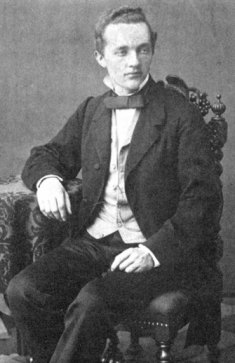Louis Paulsen facts for kids
Louis Paulsen (born January 15, 1833 – died August 18, 1891) was a German chess player. He was one of the best players in the world during the 1860s and 1870s. Louis was the younger brother of another chess player, Wilfried Paulsen.
Paulsen was one of the first players to challenge a popular idea in chess. Many believed that a strong attack could always win. Paulsen argued that even the most brilliant attack would fail if the opponent defended correctly. His ideas influenced other famous chess players. Wilhelm Steinitz agreed that attack and defense were equally important. Aron Nimzowitsch even called Paulsen one of the greatest "defensive players."
Paulsen and Paul Morphy were early masters of chess. They were also very good at blindfold chess. This means playing chess without looking at the board. They could play up to 10 blindfold games at the same time! And they made very few mistakes.
In 1857, Paulsen played in the final of the First American Chess Congress. He lost to Paul Morphy. Paulsen also played against Adolf Anderssen. They drew an eight-game match in 1862. Later, Paulsen defeated Anderssen in matches in 1876 and 1877.
Contents
Paulsen's Chess Ideas
Paulsen Pawns
Paulsen pawns is a special term in chess. It was created by the player Nimzowitsch. It describes a specific setup of pawns. For Black, it means having pawns on squares d6 and e6. For White, it's pawns on d3 and e3. This setup often comes with an open c-file.
This pawn setup makes it hard for the opponent to start a quick attack. Paulsen pawns are a key part of the Paulsen Variation. This variation is used in the Sicilian Defence.
Chess Opening Contributions
Louis Paulsen made many important contributions to chess openings. These are the first few moves of a chess game.
Sicilian Dragon
Paulsen helped create the modern form of the Dragon Variation. This happened around 1880. Other players like Henry Bird used it often. It became widely accepted around 1900.
The Dragon Variation is a main line in the Sicilian Defence. It starts with these moves:
- 1.e4 c5 2.Nf3 d6 3.d4 cxd4 4.Nxd4 Nf6 5.Nc3 g6
In this opening, Black moves a bishop to a long diagonal. This is called a fianchetto. The Dragon Variation is known for being very sharp. This means games can become very exciting and tactical quickly.
Sicilian Defence, Paulsen Variation
Another variation in the Sicilian Defence is named after Paulsen. It's called the Paulsen Variation. It can start in two ways:
- 1.e4 c5 2.Nf3 e6 3.d4 cxd4 4.Nxd4 a6
or
- 1.e4 c5 2.Nf3 e6 3.d4 cxd4 4.Nxd4 Nc6 5.Nc3 a6
Paulsen Attack in the Scotch Game
The move 7.Bb5 in the Scotch Game is also linked to Paulsen. It's known as the Paulsen Attack. The moves are:
- 1.e4 e5 2.Nf3 Nc6 3.d4 exd4 4.Nxd4 Bc5 5.Be3 Qf6 6.c3 Nge7 7.Bb5.
Paulsen Variation in the Vienna Game
In the Vienna Game, after 1.e4 e5 2.Nc3 Nc6, the move 3.g3 is called the Paulsen Variation. Paulsen used this move five times in the Vienna 1873 chess tournament.
Paulsen Attack in the Center Game
The main line of the Center Game is sometimes called the Paulsen Attack. It goes:
- 1.e4 e5 2.d4 exd4 3.Qxd4 Nc6 4.Qe3.
See also
 In Spanish: Ludwig Paulsen para niños
In Spanish: Ludwig Paulsen para niños


